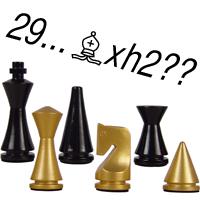
Blunders in Modern Play, The End
Today we will wrap-up the topic of blunders in modern play with three endgame examples from the recent Topalov vs. Laznicka match. The traditional Sachova Corrida Novoborska match, which took place in Prague, featured six games between these two top-class players. GM Topalov who is famous for his uncompromising style and creativity, clinched the match with a convincing 4-2 score. Here, we will analyze the endgames from the first three rounds and we'll study the positions where the blunders have occurred.
The first position is from the first match game: the tension is high and both players would like to take an early lead. The position is of a highly fighting nature and all kinds of things are happening. Although Black is up a pawn, his position is not necessarily better for several reasons. The biggest reason is that White got two strong bishops — with Bc4 pinning Nd5 and creating some discomfort for the black pieces. If the black pawn was on f7 instead of f5 his structure would have been much better and the problem of a weak a2-g8 diagonal would not exist. The white king is weak with the light squares being undermined, as the g2-pawn is missing, and with the presence of Bb7. GM Topalov effectively solved the weaknesses of his position by transposing into an endgame. In the endgame the pair of his bishops will particularly show.
With his tactical move 28...Kh8 GM Laznicka managed to preserve an extra pawn but at the cost of putting his pieces in awkward positions. I wonder if he was playing this position for a win. This would explain his 28...Kh8 move, because otherwise I see no reason why he wouldn't play the more natural 28...Kf7 and defend the position with equal material but an active king? Regardless of his thinking process, 28...Kh8 was a very strong move and the position that we have reached is a critical position.
Where should the knight go? Ideally, we want our knight safe and we don't want to give White a passed a-pawn because, supported by the two bishops, the passed pawn can be very dangerous. The moves 30...Na4 and 30...Nd5 do not solve this problem as White takes the a7-pawn, leaving Black with a tough defense. 30...Nb1 requires some serious calculations and evaluations as the 31...Nd2 threat is not easy to meet.
However, the most simple solution is 30...Bd5!. We want to liquidate the white bishops and it is absolutely crucial to see the follow-up ... Ne2+. Because if we look only at ...Nxd5 then the position is bad for Black, as White has a bishop and a passed a-pawn against a black knight. So 30...Bd5 is a deflection of the white bishop from the e2-square.
GM Laznicka blundered here. Maybe he was low on time and panicked. I think spotting 30...Bd5 is not that hard for a GM of his level. Maybe he thought that ...Nxa2 leads to an easy draw? The crucial point of the position with two bishops vs. one is that if White exchanges the light-squared bishop, then he can still win with the passed h-pawn because h8 is a dark square.
After suffering this loss, which could have been avoided, GM Laznicka did take revenge in the 2nd game of the match and we will look at what happened in the 3rd game. The material balance is unusual with White having the two bishops but being down a significant amount of material: an exchange and two pawns. He will win back one of the pawns, but he'll still have a material disadvantage.
It looks like GM Topalov likes having the two bishops as this is the second game that we are looking at where he managed to preserve them until late in the game. It turns out that dynamics play a more important role here than static advantages and White has the upper hand in this position. This is because Black is severely underdeveloped with Bc8 and Ra8 still stuck at their initial positions. Black has also major problem on h6. If White manages to double on the h-file the pawn will fall and most-likely checkmate will follow.

Photo courtesy Vladimir Jagr
This example is about pawn breaks and timing. First, Black has correctly played 24...e5! to free the bishop and the e6-square for his queen, so to laterally defend the h6-pawn. Then White pushed g4: the correct idea but the timing was wrong. The last pawn bait 31.e6! was too strong for Black to resist and the game ended up to be a fighting draw!
After three games the match was tied. We'll now look ast the 4th game, where it is GM Laznicka who has the upper hand. The two passed pawns on the a- and c-file look very dangerous. The presence of opposite-colored bishops helps Black as he can blockade the light squares for the time-being. White's plan is to push the a- and c-pawns as far as possible and then to invade the seventh rank with his rooks. If Black prevents the invasion by trying to exchange the rooks, White will gladly exchange as the resulting endgames will most likely be winning for White.
Black must create counterplay as soon as possible and GM Topalov is superb at creating dynamic resources. Black's counterplay is connected to the e-pawn push and attack on the kingside. He has to bring the rook to the kingside and manage the defense of the queenside with an attack on the kingside. For a while it looks like White is winning and Black has failed to create counterplay until the moment when White finally blundered.
Abandoning the kingside with 30.Rd1 was overly optimistic as Black's play there became extremely dangerous. The correct approach was to blockade the kingside and spend some time on defensive after 30. f4, which is not an easy decision during the game. Surprising as it may sound after the rook transfer to d6 it is White who is on the verge of losing. Black's three pieces are very active and create all kind of threats against white king. The e4-pawn adds to the attacking potential of the position. White must find the only move in this position that does not lose the game, which is a very hard task at hand. Of course, if White had kept the rook on the first rank he could have avoided being in this rather unpleasant situation. GM Laznicka did not manage to find the right continuation and lost the game.
This game probably was critical and decisive for the match result. GM Laznicka had an overwhelming advantage but let GM Topalov not only escape but create enough counterplay to even win the game. After another draw in game 5, Topalov clinched the match with a win in the last round.
Next week we are starting a new series. I hope you enjoyed this series on Blunders in Modern Play and reading it made you a better chess player!
RELATED STUDY MATERIAL
- Read the intro and Part 1, Part 2, Part 3, Part 4, Part 5, Part 6 of this series;
- Read IM Bryan Smith's article on blunders;
- Check out GM Grigory Serper's series on how to avoid blunders: Part 1, Part 2, Part 3, Part 4, Part 5, Part 6;
- Watch GM Sam Shankland's video 2012 World Open Stories: Gift After Gift!;
- Improve your tactics in general (to avoid blunders!) with our Tactics Trainer.



